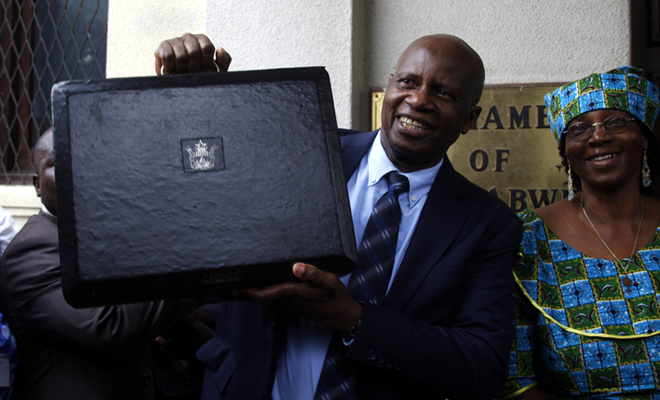By Ndakaziva Majaka
HARARE – Finance minister Patrick Chinamasa on Thursday presented a slightly smaller 2016 national budget in a clear sign that the country is curbing expenditure because of a deepening liquidity crunch.

Next year’s budget was set at $4 billion down from this year’s $4,1 billion spending plan.
The decision to cut State spending, after at least several straight years of stagnation, suggests authorities in general are becoming more cautious about spending because of the blow to State revenues.
In addition to cutting or slowing spending on projects seen as non-essential, government has been moving more aggressively to save money by reducing subsidies.
This comes as the Zimbabwe’s economy has failed to gain traction since the July 2013 elections that saw President Robert Mugabe extending his 35-year iron-fisted rule.
Chinamasa conceded that the projected $3,85 billion total revenues for 2016 limited the size of overall budget expenditures for the year and scope for manipulation to meet various fiscal expenditure demands.
“Consistent with the above budget framework, I propose a budget of $4 billion in 2016, with the projected financing gap of $150 million funded largely through borrowing on the domestic market,” Chinamasa said.
The bulk of the budget — $3,685 billion — would be gobbled by salaries and recurrent expenditure, leaving less than 8 percent for capital projects.
Despite the deteriorating economic conditions in the country, Chinamasa predicted an overly optimistic gross domestic product growth of 2,7 percent driven by agricultural recovery and growth in the mining sector, but analysts have questioned this projection.
“Accordingly, in 2016, overall gross domestic product is projected at 2,7 percent riding on the recovery of agriculture and mining as well as positive performance of the rest of the sectors,” he said.
Chinamasa’s projection comes asZimbabwe recently slashed its 2015 growth forecast by almost half to 1,5 percent due to low aggregate demand and harsh weather conditions experienced in the early part of the year.
According to Chinamasa, the deflationary pressures on the economy are set to continue into 2016, with inflation projected at -1,2 percent in December next year.
Zimbabwe was driven into deflationary territory in October last year and has remained there, with year-on-year inflation for the month of October 2015 standing at –3,29 percent due to sluggish domestic demand and a weak Rand.
According to Chinamasa, Zimbabwe which owes the International Monetary Fund (IMF), World Bank and African Development Bank $1,8 billion in arrears, now has a total public debt of $8,3 billion.
The minister also said if Zimbabwe successfully completes an IMF staff-monitoring programme that ends in December, Harare could start funding talks.
In his budget allocations, Chinamasa awarded the largest chunk to Agriculture which received $1,7 billion, education got $810 million while the Home Affairs ministry got $396 million as the Defence ministry got $358 million with $331million going to Health.
He said while the consolidation of the country’s mining companies had already started with the registration of the Zimbabwe Diamond Mining Corporation, there was still more to be done.
He also said government had acquired mining equipment from Belarus to undertake expanded diamond mining.
The treasury chief also scrapped import duty on capital equipment and imports valued at a minimum of $1 million for agriculture, mining, energy and the manufacturing sector.
Government had also licensed 12 smelting companies to export chrome ore after the temporary lifting of the chrome export ban in June.
According to the minister, gold production was projected to reach 24 tonnes in 2016 against this year’s expected target of 18,7 tonnes.
He projected a marginal decline in imports from $6,3 billion in 2015 to $6,2 billion in 2016, adding that exports were set to surge to $3,7 billion from $3,4 billion. Daily News






